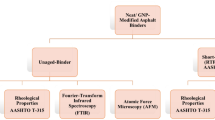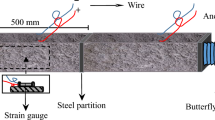Abstract
This paper presents the development of micro-mechanical discrete element model for hot mix asphalt (HMA) mixtures modified with carbon nanofibers using the advanced imaging techniques. Shape-structural model of two-phased HMA consisting of aggregate and matrix was generated using cluster of small discrete disk-shaped particles for each phase. Three contact models, shear and normal stiffness, static and sliding friction, and inter-particle contact bonds were employed to model the constitutive behavior of the HMA mixture. To validate the developed DEM model an experimental study was executed. It was observed that the uniaxial compressive test simulation reasonably predicted the stress–strain behavior of the HMA mixture. The dynamic modulus and strength obtained from indirect tensile test were similar to the predicted moduli and strength using the DEM under the quasi-elastic state for all the HMA mixtures studied.












Similar content being viewed by others
References
Papagiannakis AT, Abbas A, Masad E (2002) Micromechanical analysis of viscoelastic properties of asphalt concretes. Transp Res Rec 1789:113–120
Dai Q, Sadd MH, You Z (2006) A micromechanical finite element model for linear and damage-coupled viscoelastic behaviour of asphalt mixture. Int J Numer Anal Meth Geomech 30(11):1135–1158
Collop AC, McDowell GR, Lee Y (2004) Use of the distinct element method to model the deformation behavior of an idealized asphalt mixture. Int J Pavement Eng 5(1):1–7
You Z (2003) Development of a micromechanical modeling approach to predict asphalt mixture stiffness using the discrete element method. Doctoral Dissertation, University of Illinois at Urbana-Champaign, Urbana
Buttlar WG, You Z (2001) Discrete element modeling of asphalt concrete: a micro-fabric approach. Transp Res Rec 1757:111–118
You Z, Buttlar WG (2005) Application of microfabric discrete element modeling techniques to preict complex modulus of asphalt–aggregate hollow cylinders subjected to internal pressure. J Transp Res Rec 1929:218–226
Abbas AR (2004) Simulation of the micromechanical behavior of asphalt mixtures using the discrete element method. Doctoral Dissertation, Department of Civil and Environmental Engineering Washington State University, San Jose
Adhikari S, You Z (2008) Distinct element modeling of the asphalt mixtures: from two-dimensional to three-dimensional models. Paper no. 08-1626, Transportation Research Board 87th Annual Meeting (CD-ROM)
You Z, Buttlar WG (2004) Discrete element modeling to predict the modulus of asphalt concrete mixtures. ASCE J Mater Civ Eng 16(2):140–146
Cundall PA (1971) A computer model for simulating progressive large scale movements in blocky rock systems. In: Proceedings of the symposium of the international society for rock mechanics, vol 1, Paper No. II-8, Nancy
Cundall PA, Strack ODL (1979) A discrete numerical model for granular assemblies. Géotechnique 29:47–65
Itasca Consulting Group (2004) ‘‘PFC 2D Ver. 3.1,’’ Minneapolis
Khattak MJ, Roussel C (2009) Micromechanical modeling of hot-mix asphalt mixtures by imaging and discrete element methods. J Transp Res Rec 2127:98–106
Liu Y, You Z (2011) Discrete-element modeling: impacts of aggregate sphericity, orientation, and angularity on creep stiffness of idealized asphalt mixtures. J Eng Mech 137(4):294–303
Chen j, Huang B, Chen F, Shu X (2012) Application of discrete element method to superpave gyratory compaction. Road Mater Pavement Des:480–500. doi:10.1080/14680629.2012.694160
Mahmoud E, Masad E, Nazarian S (2010) Discrete element analysis of the Influences of aggregate properties and internal structure on fracture in asphalt mixtures. J Mater Civ Eng 22(1):10–20
Khattak MJ, Kyatham V (2008) Visco-elastic modeling of lime-modified asphalt matrix and hot mix asphalt under moisture damage. J Transp Res Board, No. 2057. National Research Council, Washington D.C.
Kim YR, Momen M, King M (2005) Report No. FHWA/NC/2005-03 typical dynamic moduli for north carolina asphalt concrete mixtures. Final Report, FHWA
Murrell SAF (1958) The strength of coal under triaxial compression. In: Walton WH (ed) Mechanical properties of non-metallic brittle materials. Butterworths, London, pp 123–145
Griffith AA (1921) The phenomena of rupture and flow in solids. Phil Trans R Soc (London) A 221:163–198
Griffith AA (1925) Theory of rupture. In: Proceedings of the 1st congress of applied mechanics. Technische Bockhandel en Drukkerij, Delft, 1924, pp 55–63
McClintock FA, Walsh JB (1967) Friction on Griffith cracks under pressure. In: Proceedings of the 4th U.S. Congress of Applied Mathematics, Berkeley, pp 1015–1021
Acknowledgments
The authors wish to express their sincere thanks to the University of Louisiana at Lafayette for using their facility and financial support. Special thanks are also extended to Mr. Mark Leblanc, laboratory assistant for assisting in experimentations.
Author information
Authors and Affiliations
Corresponding author
Rights and permissions
About this article
Cite this article
Khattak, M.J., Khattab, A., Rizvi, H.R. et al. Imaged-based discrete element modeling of hot mix asphalt mixtures. Mater Struct 48, 2417–2430 (2015). https://doi.org/10.1617/s11527-014-0328-1
Received:
Accepted:
Published:
Issue Date:
DOI: https://doi.org/10.1617/s11527-014-0328-1




